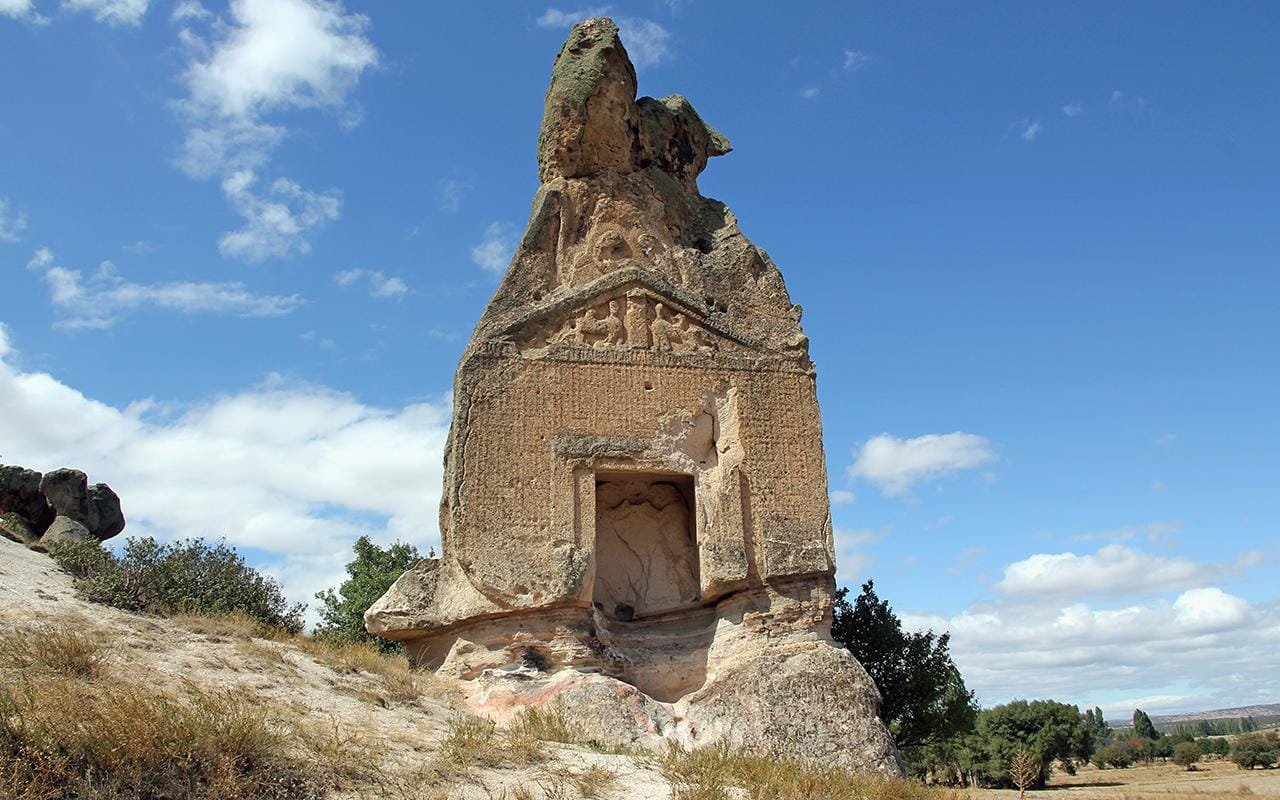A centuries-old mystery surrounding a 2,600-year-old inscription on the Arslan Kaya (“Lion Rock”) monument in western Turkey has been resolved. Professor Mark Munn of Pennsylvania State University has deciphered the weathered text, identifying the word “Materan,” a reference to the Mother Goddess of the Phrygians.
 A view of the Arslan Kaya monument in Turkey. Credit: Ingeborg Simon / Wikimedia Commons, CC BY-SA 3.0
A view of the Arslan Kaya monument in Turkey. Credit: Ingeborg Simon / Wikimedia Commons, CC BY-SA 3.0
Located in the Phrygian highlands near Lake Emre Gölü, the Arslan Kaya monument is carved into a volcanic rock formation approximately 15 meters high. Its façade features reliefs of lions, sphinxes, and geometric patterns, with a niche containing the eroded figure of Materan. This goddess, known to the Phrygians simply as “the Mother,” was later revered by the Greeks as the “Mother of the Gods” and by the Romans as “Magna Mater” or “Great Mother.”
The inscription, damaged by centuries of weathering, looting, and vandalism, has been a source of scholarly debate since the monument’s discovery in 1884 by William Ramsay. Early attempts to interpret the text were inconclusive, with researchers identifying fragmented letters but failing to reconstruct a coherent message. Munn’s breakthrough came through detailed pH๏τography under favorable lighting conditions, particularly on the morning of April 25, 2024, when the angle of the light revealed previously obscured details. By comparing these pH๏τographs with 19th-century records, Munn confirmed the presence of the word “Materan” and additional characters typical of Phrygian inscriptions.
“Much depends upon the favorability of the light when pH๏τographs are taken,” Munn explained in his article. His work built upon interpretations by earlier scholars, including Alfred Körte, who suggested the presence of “Materan” as early as the late 19th century, though his reading was uncertain.
 The heavily deteriorated inscription beneath the figures of the pediment. Credit: Ingeborg Simon / Wikimedia Commons, CC BY-SA 3.0
The heavily deteriorated inscription beneath the figures of the pediment. Credit: Ingeborg Simon / Wikimedia Commons, CC BY-SA 3.0
Materan’s prominence in the inscription aligns with the monument’s artistic and architectural elements, which Munn dates to the first half or middle of the 6th century BCE. This period coincides with the height of the Lydian Empire, which likely dominated the region at the time. The goddess’s image, flanked by lions and accompanied by sphinxes, symbolizes protection and power, key themes in Phrygian cosmology.
The text likely formed part of a larger dedication, perhaps naming the individual who commissioned the monument or invoking Materan’s protection. Such dedications were common in ancient cultures. As Munn noted, “The deity known as Materan was likely used to substantiate the political domination of Lydia and their relationship with the subject people of Phrygia.”
 The Arslan Kaya monument is carved into a volcanic rock formation approximately 15 meters high. Credit: Ingeborg Simon / Wikimedia Commons, CC BY-SA 3.0
The Arslan Kaya monument is carved into a volcanic rock formation approximately 15 meters high. Credit: Ingeborg Simon / Wikimedia Commons, CC BY-SA 3.0
The stylistic details of the inscription, including its tall and angular letters, also reflect the influence of Lydian artistic traditions. The use of palmette motifs and geometric designs further supports this connection, highlighting a shared cultural and religious heritage between Lydia and Phrygia.
While Munn’s findings affirm long-held interpretations of the inscription, they are not without critique. Rostyslav Oreshko, a lecturer at the Practical School of Advanced Studies in France, pointed out that the reading “Materan” had been proposed as early as the 19th century. “Munn’s article in Kadmos does not propose something radically new about the inscription; it simply sets straight the reading,” Oreshko told Live Science. Nevertheless, Munn’s research provides crucial evidence to end over a century of debate about the monument’s meaning and significance.
More information:Munn, Mark. (2024). The Phrygian inscription W-03 on the Arslan Kaya monument, Kadmos, vol. 63, no. 1-2, pp. 79-92. doi:10.1515/kadmos-2024-0005





